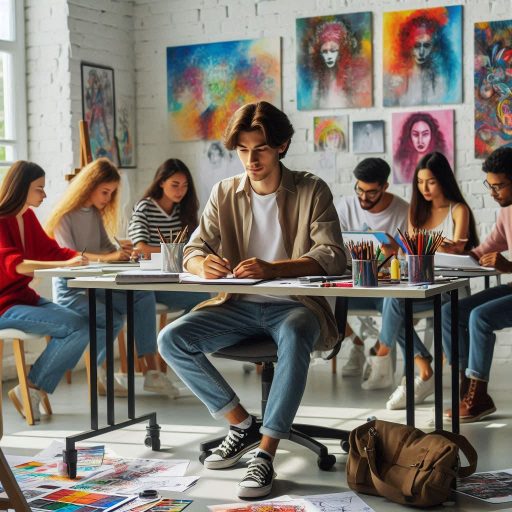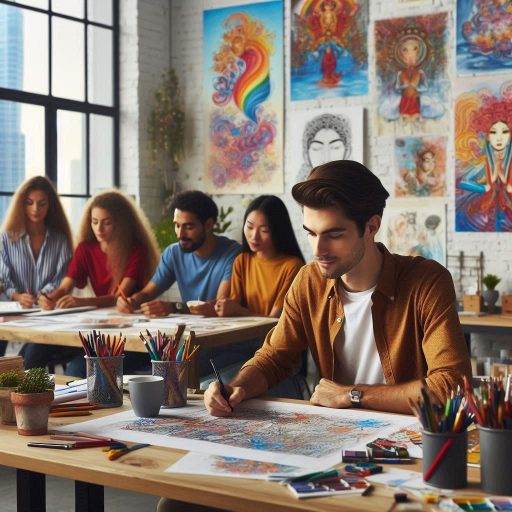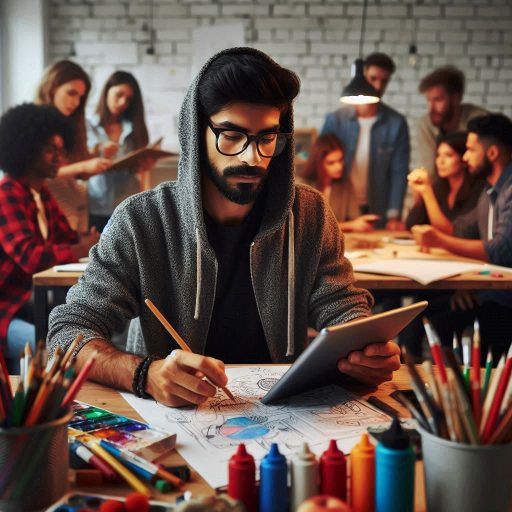Introduction
Concept artist as a foundational element in various industries, including gaming, film, and advertising.
It provides visual representations of ideas, characters, and environments.
This art form helps teams visualize concepts before production begins.
Concept artist play a crucial role in shaping these initial ideas.
They translate abstract thoughts into tangible visuals that guide the entire project.
Their work establishes the look and feel of a project, influencing design choices down the line.
In gaming, Concept artist create characters and worlds that enhance gameplay and storytelling.
In film, they visualize scenes and characters, providing a roadmap for the production team.
Advertising relies on concept art to develop compelling visuals that capture audiences’ attention and convey brand messages.
The significance of concept art extends beyond mere visuals; it sets the tone and direction for a project.
As projects evolve, concept artist must adapt and refine their work based on feedback.
Understanding their role highlights the importance of effective collaboration within creative teams.
Overall, concept artist are essential in the initial stages of creating visual assets for successful projects.
Lack of clear direction from clients or art directors
How concept artists often face challenges when clients or art directors are unable to articulate their vision clearly
Concept artists frequently encounter challenges when clients or art directors cannot articulate their vision clearly.
This lack of direction complicates the creative process.
When expectations are vague, artists struggle to translate ideas into visual concepts.
As a result, misunderstandings arise, leading to wasted time and effort.
Furthermore, artists may produce work that does not meet client expectations.
This situation can create frustration on both sides.
How this can lead to misunderstandings and revisions throughout the design process
Miscommunication can result in multiple revisions throughout the design process.
Concept artists often find themselves going back to square one.
This back-and-forth can be exhausting and disheartening.
It also delays project timelines, affecting overall workflow.
Ultimately, unclear direction undermines the artist’s creativity and hinders effective collaboration.
Strategies for concept artists to communicate effectively with clients to avoid this issue
To mitigate these challenges, concept artists must develop effective communication strategies.
One strategy is to ask clarifying questions upfront.
By seeking specific information, artists can gain a clearer understanding of client expectations.
Questions should focus on key elements such as style, color schemes, and desired emotions.
This approach helps establish a solid foundation for the project.
Additionally, concept artists can benefit from creating mood boards.
Mood boards visually represent ideas, styles, and themes.
Presenting these boards to clients fosters discussion and feedback.
They also serve as reference points throughout the design process.
Artists can use mood boards to ensure alignment with the client‘s vision.
Regular check-ins during the design process are crucial.
Scheduling these meetings provides opportunities for feedback and course correction.
Concept artists should encourage open dialogue with clients.
This transparency builds trust and allows for adjustments along the way.
Another effective strategy is to establish clear project milestones.
By breaking the project into manageable phases, artists can present their work incrementally.
Clients can provide feedback on each phase, minimizing the risk of misunderstandings.
This method also keeps the project on track and ensures alignment with client expectations.
Documentation plays a vital role in effective communication.
Concept artists should document discussions, agreements, and feedback.
Keeping records helps maintain clarity and accountability.
If questions arise later, artists can refer back to this documentation.
This practice fosters a collaborative environment where everyone stays informed.
Concept artists often face challenges due to unclear direction from clients or art directors.
This ambiguity can lead to misunderstandings and excessive revisions.
By employing effective communication strategies, artists can minimize these challenges.
Asking clarifying questions, creating mood boards, and maintaining regular check-ins are essential.
Establishing clear milestones and keeping thorough documentation also support effective collaboration.
Read: Networking Events for Costume Designers
Tight deadlines and pressure to produce high-quality work
Intense time constraints that concept artists often work under, especially in industries
Concept artists frequently face intense time constraints, particularly in the gaming industry.
Strict deadlines are common, often dictating the pace of the creative process.
Developers expect quick turnarounds to keep projects on schedule.
This pressure can lead to rushed work and heightened stress levels.
Artists may find themselves juggling multiple projects simultaneously, exacerbating the demand for speed.
Consequently, the creative environment can become overwhelming.
How this pressure can impact the quality of the artwork and the artist’s creative process
The pressure to produce high-quality work under tight deadlines can significantly impact artists.
They may sacrifice artistic integrity for expedience.
Rushed decisions often result in less polished artwork, affecting the final product’s overall quality.
Furthermore, this environment can stifle creativity.
Artists may feel they cannot explore innovative ideas due to time constraints.
The focus shifts from creativity to simply meeting deadlines, diminishing the joy of artistic expression.
Tips for managing time effectively and maintaining quality despite tight deadlines
To thrive under pressure, concept artists must adopt effective time management strategies.
Prioritizing tasks is essential.
Artists should assess their workload and focus on high-impact tasks first.
Creating a list of priorities helps streamline the workflow.
This approach ensures that essential elements receive adequate attention, allowing artists to maintain quality.
Breaking projects into smaller, manageable tasks is also beneficial.
This method prevents artists from feeling overwhelmed.
By tackling one aspect at a time, they can maintain focus and clarity.
Setting mini-deadlines for each task can help keep the project on track.
Additionally, artists should establish a structured daily routine.
Allocating specific time blocks for focused work allows for greater productivity.
During these periods, minimizing distractions is crucial.
Turning off notifications and creating a dedicated workspace can enhance concentration.
Utilizing productivity techniques, such as the Pomodoro Technique, can also be effective.
This method involves working in short bursts followed by short breaks.
By maintaining this cycle, artists can prevent burnout and sustain creativity throughout the day.
Another vital strategy is to communicate with team members.
If deadlines seem unmanageable, artists should express their concerns.
Open communication fosters collaboration and may lead to revised timelines.
Team discussions can also help identify solutions to alleviate pressure.
Incorporating tools and software designed for artists can enhance efficiency.
Digital platforms often offer features that streamline workflows, such as asset management and quick rendering options.
Familiarizing oneself with these tools can save valuable time.
Finally, maintaining a healthy work-life balance is crucial.
Taking breaks and allowing time for self-care can rejuvenate creativity.
Engaging in hobbies outside of work can help alleviate stress and prevent burnout.
Concept artists face significant pressure from tight deadlines and high-quality expectations.
These challenges can impact both the quality of their work and their creative process.
Read: Freelance vs. In-House Costume Design Jobs
Balancing creativity with client expectations
The challenge of balancing artistic freedom with meeting the expectations and requirements of clients
Concept artists often face the challenge of balancing their creativity with client expectations.
While artistic freedom fuels innovation, clients have specific visions for their projects.
This dynamic can create tension, as artists must navigate the space between personal expression and meeting contractual obligations.
Striking this balance is essential for creating compelling artwork while satisfying client needs.
Artists may feel conflicted when they have to compromise their vision to align with client demands.
How some clients may have specific guidelines or constraints that limit the artist’s creative expression
Clients frequently provide guidelines or constraints that can restrict artistic expression.
These requirements might include brand guidelines, thematic elements, or technical specifications.
Such constraints can lead to frustration for artists who wish to explore their creativity fully.
For example, a client may prefer a specific color palette or style that does not align with the artist’s strengths.
This can hinder the artist’s ability to showcase their unique style.
In some cases, clients may also have a particular audience in mind.
This target audience can further dictate the artistic direction, leaving little room for exploration.
While these guidelines ensure that the artwork aligns with the client‘s goals, they can limit an artist’s creative freedom.
Ways for concept artists to navigate this delicate balance and still produce compelling work
Navigating this delicate balance requires strategic approaches from concept artists.
First, artists should seek to understand client expectations clearly.
Engaging in open dialogue with clients about their vision can help artists align their creative processes with the client’s goals.
Asking questions and actively listening to feedback ensures that artists grasp the essence of what the client wants.
Additionally, concept artists can present multiple ideas during the initial stages.
Providing clients with various options can facilitate a collaborative process.
This approach allows artists to showcase their creativity while adhering to client guidelines.
Artists can highlight unique interpretations within the provided constraints, enhancing the overall design.
Another effective strategy is to establish boundaries for creative input.
Artists can clarify areas where they feel comfortable exploring their creativity while respecting client requirements.
This balance allows for artistic expression while keeping the project on track.
Concept artists should also view client guidelines as opportunities rather than restrictions.
Embracing constraints can lead to innovative solutions.
Artists can push the boundaries of their creativity by finding unique ways to incorporate guidelines into their designs.
Networking and building relationships within the industry can also be advantageous.
Collaborating with other professionals allows artists to gain insights into managing client expectations.
Learning from peers can provide new perspectives on balancing creativity with requirements.
Finally, artists should remember to prioritize self-care and personal projects.
Engaging in personal work outside client projects fosters creativity and prevents burnout.
This balance ensures that artists maintain their passion and innovative spirit.
Balancing creativity with client expectations presents challenges for concept artists.
While client guidelines can limit artistic freedom, effective communication and collaboration can enhance the process.
Read: Collaborating with Other Creative Roles

You Might Also Like: Interview Tips for Aspiring Lighting Designers
Keeping up with evolving technologies and software
Need for concept artists to constantly update their skills and adapt to new technologies and software tools
In the fast-paced world of concept art, staying relevant requires constant skill updates.
New technologies and software tools emerge frequently, influencing how artists create.
Concept artists must adapt to these changes to maintain their competitiveness in the industry.
This adaptability is crucial, as outdated skills can hinder an artist’s ability to deliver high-quality work.
Mastering new tools enhances an artist’s efficiency and expands their creative possibilities.
How advancements in digital art and design can create challenges for artists who are not tech-savvy
However, advancements in digital art and design can pose challenges, especially for those who are not tech-savvy.
New software often comes with a steep learning curve.
Artists accustomed to traditional techniques may feel overwhelmed when transitioning to digital platforms.
This transition can lead to frustration and a sense of inadequacy.
Additionally, not staying updated with technological advancements can result in missed opportunities.
Clients often seek artists proficient in the latest tools, which can exclude those who struggle with new technology.
The gap between tech-savvy artists and those who resist change can widen, impacting career advancement and job prospects.
Resources and training opportunities for concept artists to stay current in a rapidly changing industry
To navigate these challenges, concept artists should actively seek resources and training opportunities.
Online platforms offer courses specifically designed for artists.
Websites like Skillshare, Udemy, and Coursera provide access to tutorials on popular software such as Adobe Photoshop, Blender, and Procreate.
These resources allow artists to learn at their own pace and focus on areas they find challenging.
Participating in webinars and workshops can also be beneficial.
Many art conferences host sessions focused on new technologies and software tools.
These events provide hands-on experience and direct interactions with industry experts.
Networking during these events can lead to mentorship opportunities, further enhancing an artist’s skills.
Additionally, engaging with online communities and forums can be invaluable.
Platforms like Reddit, DeviantArt, and ArtStation allow artists to connect with peers.
Sharing tips and experiences within these communities fosters a supportive learning environment.
Artists can discover new resources and gain insights into the latest trends and tools in the industry.
Furthermore, concept artists should dedicate time to practice with new software.
Regular practice helps build familiarity and confidence.
Setting aside specific times for learning and experimentation can facilitate skill development.
Finally, artists can follow industry leaders and influencers on social media.
This exposure can provide inspiration and updates on new tools and techniques.
Artists should consider subscribing to industry-related blogs and YouTube channels for ongoing education.
Keeping up with evolving technologies and software is essential for concept artists.
The rapid pace of change can be daunting, especially for those not comfortable with technology.
However, numerous resources and training opportunities are available to help artists stay current.
By embracing lifelong learning and actively seeking out new skills, Concept artist can thrive in a competitive industry and continue to create impactful work.
Read: Top Skills Needed for Art Educators and Instructors
Dealing with artistic block and creative burnout
Acknowledge the struggle of concept artists to maintain a high level of creativity and inspiration consistently
Concept artists often face the challenge of maintaining a steady flow of creativity and inspiration.
This pressure can lead to artistic blocks and creative burnout, impacting their productivity and passion for their craft.
The demands of tight deadlines, client expectations, and the need for constant innovation can overwhelm even the most dedicated artists.
Recognizing this struggle is the first step toward finding effective solutions.
How artistic block and burnout can hinder the artist’s ability to generate new ideas and concepts
Artistic block can manifest as a lack of ideas or motivation to create.
When faced with a creative block, artists may feel frustrated and disheartened.
This feeling can be exacerbated by external pressures, making it difficult to generate new concepts.
Similarly, creative burnout occurs when artists exhaust their mental and emotional resources.
This state can lead to diminished enthusiasm for their work, causing a downward spiral in creativity.
The inability to produce new ideas can hinder career advancement and affect overall job satisfaction.
Transform Your Career Today
Unlock a personalized career strategy that drives real results. Get tailored advice and a roadmap designed just for you.
Start NowTips and techniques for overcoming creative blocks and preventing burnout in a demanding creative field
To combat artistic block and burnout, artists can adopt several strategies.
First, taking breaks is essential.
Short breaks throughout the day allow the mind to recharge and can spark new ideas.
Stepping away from work, even briefly, can provide fresh perspectives upon returning.
Establishing a routine can also help maintain creativity.
Setting aside specific times for creative work creates a structured environment.
Artists should also include time for relaxation and self-care in their routines.
Balancing work and personal time can prevent burnout and sustain long-term creativity.
Engaging in different creative activities outside of concept art can provide inspiration.
Exploring other artistic mediums, such as painting, writing, or photography, can stimulate creativity.
This exploration can lead to new ideas and fresh approaches to concept art.
Collaborating with fellow artists can also be beneficial.
Sharing ideas and working together can inspire new directions in creativity.
Feedback from peers can offer valuable insights and encouragement, helping artists break through blocks.
Maintaining a sketchbook is another effective technique.
Regularly sketching, even without a specific purpose, allows artists to explore ideas freely.
This practice can serve as a pressure-free outlet for creativity and lead to unexpected breakthroughs.
Additionally, artists should embrace imperfections in their work.
Allowing oneself to create without the pressure of perfection can reduce stress.
This approach encourages exploration and experimentation, which can reignite passion for the craft.
Lastly, practicing mindfulness and self-reflection can help artists understand their creative cycles.
Being aware of personal triggers for burnout or blocks can facilitate proactive measures.
Techniques such as meditation, journaling, or yoga can promote mental clarity and emotional well-being.
Dealing with artistic block and creative burnout is a common challenge for concept artists.
Recognizing these struggles is crucial to finding effective solutions.
Conclusion
Concept artist face numerous challenges in their creative journeys.
Communication issues with clients or art directors often lead to misunderstandings and revisions.
Additionally, tight deadlines put immense pressure on artists, impacting the quality of their work.
Balancing artistic freedom with client expectations can stifle creativity, while the need to keep up with technological advancements can create additional hurdles.
Furthermore, creative blocks and burnout are common struggles that hinder the flow of ideas and inspiration.
Overcoming these challenges requires resilience, adaptability, and a commitment to continuous learning.
Artists must develop strong communication skills to clarify visions and expectations.
Managing time effectively helps maintain quality under pressure, while embracing new technologies can enhance artistic capabilities.
Additionally, fostering a supportive network and exploring different creative outlets can help combat artistic blocks and burnout.
By prioritizing personal growth and skill development, concept artist can navigate the complexities of their profession.
Cultivating these qualities enables them to thrive in the competitive world of concept art, transforming challenges into opportunities for innovation and artistic expression.
[E-Books for Sale]
The Big Book of 500 High-Paying Jobs in America: Unlock Your Earning Potential
$19.99 • 500 High-Paying Jobs • 330 pages
Explore 500 high-paying jobs in America and learn how to boost your career, earn more, and achieve success!
See All 500 High-Paying Jobs of this E-Book
1001 Professions Without a Degree: High-Paying American Jobs You Can Start Now
$19.99 • 1001 Professions Without a Degree • 174 pages
Discover 1001 high-paying jobs without a degree! Unlock career tips, skills, and success strategies for just $19.99!




